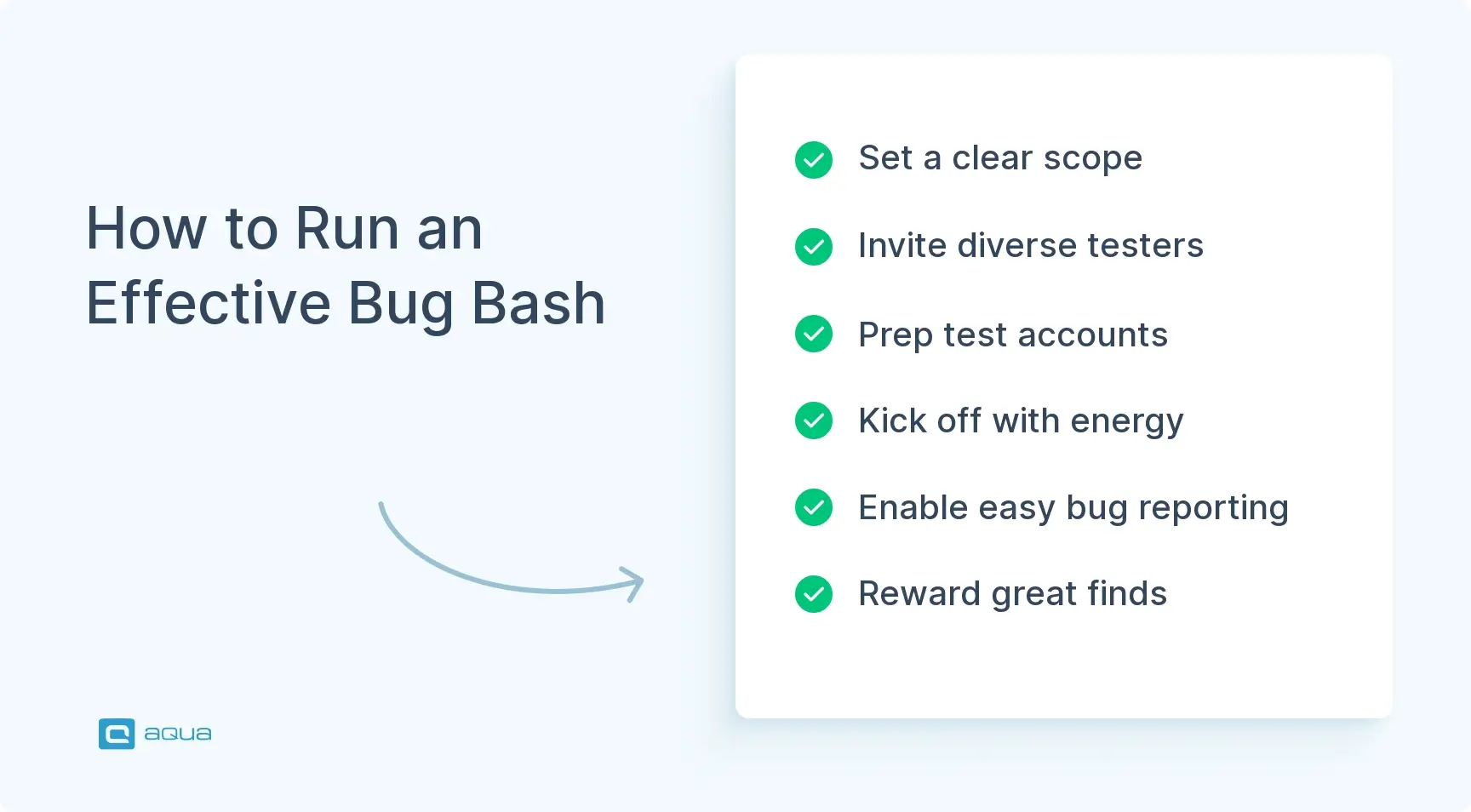A bug bash is what happens when you open the gates and let your whole team, including devs, designers, PMs, and even marketing, loose on your product. And why would you do that? Let’s cover it fully in our article.
What's a Bug Bash?
So what’s the deal with a bug bash? Basically, it’s a focused testing where a group of developers, testers, product managers, designers, and even marketing people all pile in. The goal is to find and log as many software bugs as possible in a short, sharp burst.
Think of it as a mini testing party, or organised anarchy. It’s collaborative, fast-paced. You’re not just relying on QA. You’re bringing in fresh eyes, different devices, and unpredictable usage patterns. That includes:
- Designers are trying to submit empty forms
- Devs poking the API through the UI
- Product managers are discovering that their “beautiful” flow breaks on iPhone SE
You get the picture.
It’s less about process, more about people. And because everyone sees the product from a different angle, you get edge cases and gnarly bugs that structured testing might miss.
But bug bash is not a substitute for formal testing (such as unit tests or dedicated QA testing). Instead, it is a complementary activity to capture issues in a highly focused manner. It increases the likelihood of discovering elusive, corner-case bugs.
Why Does Your Team Need Bug Bash?
One word: coverage.
In an ideal world, your automated tests catch regressions, your QA team flags inconsistencies, and your devs don’t introduce new bugs. In reality? Blind spots exist. Almost always.
Here’s what a good bug bash covers:
- Hidden usability traps (that only someone outside QA notices)
- Edge cases and freak behaviours (“what if I hit back 4 times?”)
- Real-world usage on random devices, browsers, network speeds
This way, you get the whole picture of your product by putting it in a realistic testing environment where all perspectives matter.
Benefits of Bug Bash
Think bug bashes are just chaotic free-for-alls? Think again. When done right, they’re one of the most powerful tools in your QA arsenal – especially if you’re working agile or managing remote teams. Here’s why you should make them a regular part of your testing strategy.
Catch Bugs Early, Boost Quality Fast
This is the big win. Bug bashes help you find issues super early when they’re cheap and easy to fix. Every bug you catch during development is one less angry user ticket later. You’ll see a direct boost in product quality and user satisfaction.
Save Time and Money
Fixing bugs before release is way cheaper than emergency patches after launch. A good bug bash can prevent costly post-launch fire drills by catching problems when fixes are straightforward. Plus, you jam all that testing into a focused window instead of drawn-out testing cycles.
Get Real Coverage
Bug bashes bring together people from different backgrounds who use your software in unique ways. Developers, designers, product managers, even non-tech folks, they all test differently. This diversity helps you catch functional bugs, usability issues, and edge cases that scripted tests might miss.
We do bug bashes, but also test in prod.
Break Down Silos
Bug bashes unite your entire team: dev, QA, design, product, and beyond. Developers see how marketers actually use the app. Product managers discover what really breaks in the wild. This kind of shared experience builds a quality-focused culture where everyone owns quality, not just QA.
Boost Team Morale
When done right, bug bashes feel like a team victory. They inject energy by making testing feel like a game. There’s friendly competition, bragging rights for great finds, and developers get a break from their usual tasks to “play” with the product. Many teams report stronger relationships and renewed passion for their projects.
Perfect for Agile Teams
Agile means everyone cares about quality and loves short feedback loops. Bug bashes deliver exactly that, because they are quick, intense feedback before sprint or release wrap-up. You can run them at the end of sprints or during hardening iterations to flush out lingering issues. Companies like QuintoAndar have made bug bashes a regular practice that ensures “both product and team quality”.
Remote Teams, No Problem
Bug bashes also work brilliantly for distributed teams. They give remote colleagues a chance to collaborate in real-time on a shared goal, which builds connection. Plus, remote participants bring diverse devices and environments to the table: different operating systems, browsers, home Wi-Fi setups. This natural diversity often produces better results than in-person sessions. While the “ideal” bug bash once meant everyone in one room, video calls and chat work just as well. You need to keep communication channels open so everyone can share findings and ask questions.
But here’s where many teams hit a wall: all these benefits disappear if you can’t properly organize, track, and act on what you discover. Running productive bug bashes is one thing, but managing the flood of findings, coordinating fixes across teams, and ensuring nothing falls through the cracks is another challenge. This is where a robust test management system (TMS) becomes essential.
Aqua cloud, an AI-powered TMS takes this responsibility and delivers the highest level of QA test management for you. With its 100% centralised repository, you can combine all your manual and automated tests together and have full control over them. 100% traceability and test coverage means you can link every single test case or scenario back to its requirement, giving you the ultimate confidence about your testing efforts. From the generative side, your team (yes, even the non-technical guys) can generate a test case, requirement, or test data within just 3 clicks, saving up to 98% of time compared to manual effort. Jira, Azure DevOps, Selenium, Jenkins, and many more integrations turn aqua cloud into a superpower, while one-click bug recording Capture integration is exactly the communication bridge you need between devs and testers. Ready to try it out?
Have 100% control over your testing process even during bug bashes
When should you bug bash?
Bug bashes are commonly held at crucial development milestones, often just before a major release or launch, once the majority of planned testing is complete.
Timing is everything. You don’t throw a bug bash when your app barely loads. You wait until things are stable enough to test, but not so late that fixes will derail your launch.
So, sweet spots include:
- Right before a major release
- After new features are integrated
- Post-regression testing, pre-beta
Pro tip: Some agile teams run mini-bashes every sprint. Like a regular hygiene check before things ship.
Plan your bug bash without turning it into a circus
Great bug bashes feel chaotic on the surface. But if they’re going to deliver real value, they need structure humming underneath the fun. Why? Because if you are inviting even non-tech teammates to do QA, there should be something that makes the process interesting to them so they can take full responsibility and accountability for their actions.
Here’s how to prep without making it feel corporate:
- Set the vibe: Before anything else, decide how this bash is going to feel. Is it competitive? Collaborative? A party? A war room? Give it a theme and a name that builds excitement. “Break the Beast v2.0” or “Mission: Implausible” work better than “Bug Bash Q2.” Remember, you’re inviting people into a shared headspace.
- Define scope that inspires, not confines: Be clear about what’s in bounds. Are you focusing on a new feature? The entire checkout flow? Mobile only? A vague scope leads to testers fumbling around or everyone crowding the same area. Share a one-pager or visual map of key zones to explore, or maybe even a shared Miro board.
- Prep your weapons (aka tools): There’s nothing more frustrating than showing up to a bug bash and hitting a login wall. Set up your environment ahead of time: test accounts, seeded data, access credentials, and working builds. Use solid bug tracking software like aqua cloud, not a shared inbox or Slack thread. Templates for bug submissions? Yes, please. Bonus points if your system supports tagging or filtering by bash session.
- Draft your crew: The magic lies in who you invite. QA is great, but it’s the wildcard players, including customer support, design, even interns who bring the chaos that catches the weird bugs. Cast a wide net. And give people time to prep. An internal calendar invite + a short Loom or Notion doc with context goes a long way.
- Sweeten the deal: Gamification isn’t just for laughs, it also increases engagement. Offer simple rewards like coffee gift cards, team lunch, or “Bug Slayer of the Day” bragging rights. Recognition matters. Just make sure it rewards quality over quantity.
How to Actually Run a Bug Bash
So you have set up everything, followed the checklist for preparation. What now? How do you effectively carry out the bug bash? Let’s look at some best practices.
- Kick it off with energy, not slides: Start live, maybe Zoom or in person. Give a 10-minute warm-up: why you’re doing this, what’s in scope, where to log bugs, and what “good” looks like in a report. Show them where the guardrails are, but let them drive.
- Encourage curiosity, not just clicks: Let testers be testers. Ask them to follow real user flows, but also poke, prod, and bend things. Try signups with emoji names. Switch browsers mid-session. Pretend the Wi-Fi’s bad. Great bugs live where scripts don’t reach.
- Keep the chatter flowing: Have a Slack or Teams thread open where people can share oddities, screenshots, or memes. Pin the bug reporting doc and give shoutouts in real-time. Someone finds a nasty bug? Drop a trophy emoji.
- Capture everything, but make it easy: Not everyone’s a seasoned QA engineer. So make bug reporting frictionless. Pre-filled forms. Handy links. Ask for clear repro steps, screenshots (Capture integration, remember?), severity but don’t make it a chore. Link to your bug reporting template upfront.
- Make it fun and rewarding: Announce “Bug of the Bash” awards. Give props to the most unexpected find. Keep a live scoreboard. Even if it’s just a spreadsheet with names and tallies, it boosts engagement.

So you should think of this less like a test cycle, and more like a team sport. With good planning, it becomes both a bug hunt and a culture-building moment. And when done right, the fixes that follow are only half the value the morale boost is the real win.
What Happens After the Bash?
The bash might be over, but the bugs aren’t going to fix themselves.
This is where the real ROI kicks in. You’ve collected raw feedback, real issues, and some hilariously broken user flows. Now it’s time to transform that chaos into value.
- Start with triage, fast. Don’t let bugs gather digital dust. Block off an hour with a PM and tech lead to go through the list. Tag duplicates. Assign owners. Flag anything showstopper-worthy for immediate action. You want clarity, not clutter.
- Fix what matters. Not every typo needs a patch today, but that silent failure during sign-up? That’s a release risk. Prioritise what breaks trust, not just what breaks layout.
- Close the loop with the team. Send a quick recap to everyone who joined: what was found, what’s being fixed, who crushed it. Bonus points for a leaderboard or some spicy screenshots of the worst bugs. People love seeing their chaos in action.
- Run a 15-min retro. Gather feedback while it’s fresh. What worked? Was the scope too wide? Did the bug tracker slow anyone down? Capture these to iterate on your next session.
And finally, feed those findings into your defect management flow. Tag them. Trend them. Turn those ad-hoc insights into structured improvements.
Bug bashes are only worth it if you act on what you find. So don’t just discover, you need to also deliver.
But it can also go sideways. Let’s say you get 30 people finding 67 bugs in 2 hours, then spend the next week playing archaeological dig through scattered screenshots, vague descriptions, and duplicate reports. The energy dies, bugs get lost in translation between finders and fixers, and half your discoveries never make it into actual test cases for future releases. You need something that can handle the organised chaos of a bug bash capturing findings in real-time.
Aqua cloud is built for exactly this scenario. When your bug bash team discovers issues, they can instantly create properly documented test cases that trace back to requirements. This ensures those edge cases become part of your permanent test suite instead of getting forgotten. The AI-powered requirements, test case, and test data generation means even non-technical participants can create quality bug reports and test scenarios in three clicks, while real-time collaboration prevents the usual “wait, didn’t someone already find this?” confusion. With integrations to Jira and Azure DevOps, every bug bash finding flows directly into your development workflow, and the one-click Capture integration means your team can document issues without breaking their discovery flow. Ready to turn your next bug bash from chaos into systematic quality improvement?
Achieve 200% efficiency in your QA processes with AI-powered TMS
Here is a look at how bug bash outcomes should look:
Bug Bash Outcomes Metrics
| Metric | Example | Action |
|---|---|---|
| Total bugs found | 42 bugs in 3 hours | Compare with previous bug bashes |
| Severity distribution | 5 Critical, 12 Major, 25 Minor | Focus fixes on Critical/Major |
| Areas with most bugs | Login: 3, Checkout: 8, Profile: 2 | Additional testing for Checkout |
| Fix rate | 90% fixed within 1 week | Analyze remaining 10% for patterns |
| Participant engagement | 15 of 20 invitees active | Improve incentives for next time |
Bug Bash vs. Usual QA Processes
At this point, you might be wondering whether bug bashes should replace your existing QA processes or where they fit in your quality strategy. The answer isn’t either/or. You need to understand when each approach excels. Bug bashes complement traditional QA processes rather than replace them. Understanding their differences helps position bug bashes effectively in your quality strategy.
Let’s compare them:
Structural Differences
| Aspect | Bug Bash | Regular QA Testing |
|---|---|---|
| Approach | Exploratory, free-form | Structured, methodical |
| Participants | Cross-functional team | Primarily QA engineers |
| Duration | Time-boxed event (hours) | Ongoing process (days/weeks) |
| Coverage | Wide but potentially uneven | Systematic and thorough |
| Documentation | Minimal, focused on findings | Comprehensive test plans and cases |
| Reproducibility | Sometimes harder to reproduce | Clearly defined steps |
The best quality strategy combines both:
- Use structured QA processes for baseline coverage
- Add bug bashes to find what those processes miss
- Feed bug bash findings back into structured test cases
- Use bug bash results to refine automated tests
Many teams find that adding regular bug bashes to their existing QA processes significantly improves overall product quality.
Conclusion
A bug bash is a pulse-check on your product. A way to stress it like a user would. And maybe, just maybe, a way to fall back in love with what you’re building. Make them regular. Make them fun. And above all, make them count. Remember that bug bashes complement rather than replace your regular QA processes. The combination of structured testing and exploratory bug hunting provides comprehensive coverage that neither approach can achieve alone. So, gather your team, set a date, and start planning your next bug bash. Your users will thank you for the bugs they never encounter.


















